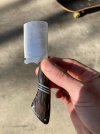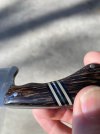Looking for a little advice on improving my handle shaping. Inside curves are giving me some trouble, especially when I've got hard materials in my spacers (steel, coper, brass, etc). It's kinda visible in the 2nd pic below, but you'll see there's a bump where the steel is in the middle of the spacer. On a couple of knives I've tried smoothing that out with a dremel and usually end up just making a mess of that area. Hand sanding can get things smooth, but I get that bump. I don't have a grinder w/ a small wheel attachment, so I'm limited on the power tool side. I use a 2x42 grinder with big wheels and a small 1x30.
I'm guessing that the key is not sanding that area w/ anything soft (fingers, sanding pads, etc). But, who knows?
Any suggestions from people much more experienced that me on how to improve that area? Many thanks!


I'm guessing that the key is not sanding that area w/ anything soft (fingers, sanding pads, etc). But, who knows?
Any suggestions from people much more experienced that me on how to improve that area? Many thanks!


